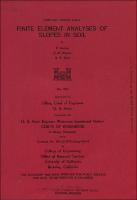Please use this identifier to cite or link to this item:
https://hdl.handle.net/11681/20538Full metadata record
| DC Field | Value | Language |
|---|---|---|
| dc.contributor | University of California, Berkeley. College of Engineering. Office of Research Services | - |
| dc.contributor | United States. Army. Office of the Chief of Engineers | - |
| dc.contributor.author | Dunlop, Peter | - |
| dc.contributor.author | Duncan, J. M. (James Michael) | - |
| dc.contributor.author | Seed, H. Bolton (Harry Bolton) | - |
| dc.date.accessioned | 2017-01-11T18:48:33Z | - |
| dc.date.available | 2017-01-11T18:48:33Z | - |
| dc.date.issued | 1968-05 | - |
| dc.identifier.uri | http://hdl.handle.net/11681/20538 | - |
| dc.description | Contract Report | - |
| dc.description | Abstract: The study described in this report was conducted to investigate the behavior of excavated slopes and embankments using the finite element method of analysis. The aspects of slope behavior considered include stresses, strains, displacements, pore pressures, and progressive development of failure zones. Analyses have been performed using nonlinear stress-strain characteristics as well as linear elastic stress-strain behavior. A method has been developed for simulating analytically the excavation of a slope in a clay layer with arbitrary initial stress conditions. Analyses performed using this procedure have shown that the behavior of an excavated slope depends on the initial horizontal stresses in the soil layer and the variation of strength with depth. Analyses performed using initial stresses and strength profiles representative of normally consolidated clays indicate behavior which is compatible with the results of short-term stability analyses; the failure zones determined strongly suggest development of a curved surface of sliding, and the factors of safety calculated by the method were close to unity at the final stage of the analysis when the failure zone encompassed a large zone between the crest and the toe of the slope. Similar analyses performed using initial stresses and strength profiles representative of over consolidated clays indicated quite different behavior; failure zones developed which intersected the bottom of the excavations and the lower portions of the slopes while the factors of safety were still about 2. These failure zones did not resemble the usual curved failure surfaces used in equilibrium analyses of slope stability, but instead suggest the development of the condition of "loss of ground" wherein the soil in the bottom of the excavation bulges up slowly as additional soil is excavated. Detailed consideration was given to the stress-strain characteristics of soft, saturated clays under undrained loading conditions. Using the results of horizontal and vertical plane strain tests on San Francisco Bay Mud, an empirical stress-strain relationship was developed for this material. The relationship developed was nonlinear, anisotropic, and dependent on the consolidation pressure. In spite of its complexity, the relationship can be represented in a reasonably simple form and could be conveniently employed in finite element analyses. Using this relationship, analyses were performed to predict the behavior of San Francisco Bay Mud under simple shear loading conditions, and the predicted behavior was found to agree quite well with experimental results. Analyses were performed to calculate pore pressures around excavated slopes and in embankment foundations using a variety of possible assumptions regarding the stress-strain behavior and the pore pressure coefficients of clay soils. The most significant factor affecting the calculated distributions were found to be anisotropy with respect to both stress-strain behavior and development of pore-water pressures. Using the finite element method it is possible to include realistic soil properties in analyses of slope performance. Nonlinear, anisotropic stress-strain relationships and anisotropic pore pressure coefficients may be incorporated in analyses in a logical and straight-forward manner, providing a means of making more accurate evaluations of stress distribution and pore pressure distributions in soil masses. | - |
| dc.publisher | U.S. Army Engineer Waterways Experiment Station. | - |
| dc.publisher | Engineer Research and Development Center (U.S.) | - |
| dc.relation | http://acwc.sdp.sirsi.net/client/en_US/search/asset/1050828 | - |
| dc.rights | Approved for public release; distribution is unlimited. | - |
| dc.source | This Digital Resource was created from scans of the Print Resource. | - |
| dc.subject | Embankments | - |
| dc.subject | Finite element method | - |
| dc.subject | Slopes | - |
| dc.title | Finite element analyses of slopes in soil : a report of an investigation | - |
| dc.type | Report | en_US |
| Appears in Collections: | Contract Report | |
Files in This Item:
| File | Description | Size | Format | |
|---|---|---|---|---|
| CR-S-68-6.pdf | 6.51 MB | Adobe PDF |  View/Open |